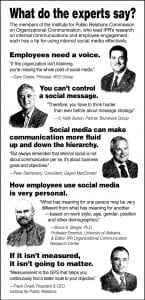Our workplaces rank among the most social environments we ever encounter. This does not mean that all workplaces have the same social media needs or opportunities. But leaders in social media for internal communications may offer useful lessons for the rest of us. Some of the earliest celebrated cases of internal social media involved blogs.
When General Motors introduced its first executive blog, FastLane, it quickly became a lightning rod for discussion and debate in trade and business channels. And many companies continue to use internal blogs to communicate important developments and allow employees to interact with their leaders.
“We have a number of examples where opening up a story for comments on our blog has led to change and guided future action,” said Todd Painter, communication manager, Southwest Airlines. “A recent example involved a flight attendant who left a comment to the effect of, ‘Can you just say thank you without any buts?’ That led to our CEO thanking employees for their efforts over the busy summer travel period—without any reminders to work harder, cut costs, etc.”
Not unlike internal blogs, intranet portals originally looked like more traditional channels, only digital. In time more resources were rolled into the portal, but often these were materials already available elsewhere, such as HR forms.
Today, however, the intranets of leading companies increasingly incorporate true social thinking.
Prior to its intended merger with US Airways, American Airlines upgraded its internal platform (called Jetnet) to introduce new social and engagement elements, and an unprecedented voice level for American’s team members. It was the primary channel for communicating a new brand-visual identity and new uniforms, the first for some employees in nearly 25 years. To date, 78,068 of 81,059 possible users have registered on the site, and 88% of the registrants have been active in the last 30 days.
INSIDE MEETS OUTSIDE
While blogs still have an important role to play in employee engagement, internal social media increasingly reflect external social media. We are two years past the point where more than half of U.S. adults regularly use social networks.
Is it any wonder that, when they go to work, they feel they have entered a time warp if the employer doesn’t get the value of such networks internally?
Twitter, Facebook and other social networks all have a place. Jill Wolf, manager of corporate communications for Exelis, said: “Don’t overlook LinkedIn as an employee channel.”
More than half of the company’s LinkedIn connections are employees, which means that more than 4,000 employees are reachable there. Some employees who don’t read the corporate newsletter might check LinkedIn daily and can add their own perspectives to corporate and employee features.
This mixing of internal and external might make some companies nervous. But if you’re smart enough to know that employees talk about their work even when the social channel is a neighborhood cookout, it’s a short step to the notion of enabling employees to act as external brand ambassadors.
By deliberately sharing information that you intend to be shared elsewhere, you not only acknowledge the blurring lines, you make employees your friend.
Of course, while the use of social media externally has “personal business” benefits, such as staying current with family and community, most of us are there for fun, too. If we don’t feel the fun, we don’t stick with it. So it is with internal social media.
Veteran internal communicators have long known you have to mix fun with business for employee audiences. “You see our trucks and buses everywhere you go,” said Lisa Hartenberger, director, corporate communications at Navistar.
She added, “We started a program called Spot Our Stuff to encourage employees to snap photos of our products in action. The original intent was to use these on a more traditional one-way channel, but we have been flooded with photos of our vehicles in all walks of life.”
NOT A CURE-ALL
If early adopters first saw social media as another employee communications channel, today it is increasingly seen as a faster track to in-house collaboration and productivity.
According to an APCO Worldwide / Gagen MacDonald 2012 survey of 1,000 U.S. adults working at companies with at least 500 employees, 61% of respondents said their company’s social media tools make it easier to collaborate.
Microsoft and Ipsos earlier this year conducted a study of 9,900 knowledge workers in 32 countries. Nearly half of the respondents said that social media tools at work helped increase their productivity, but more than 30% said that their companies underestimate the value of these tools and even restrict their use.
Chris Olson, assistant VP, internal communications at USAA, describes a platform that hosts 130 internal communities where questions are asked and answered by peers.
It started with the company’s IT community and now represents “a classic model for social business that wouldn’t be possible at this scale without social networking,” she said.
Even so, she added, “You have to keep selling the vision to leaders, especially if they aren’t naturally comfortable with social business.”
At GE, collaboration tools are a long-established, pre-social phenomenon. That perhaps made it an easier transition to an internal platform called Colab, where employees establish their own open or closed communities, groups and work spaces. “Collaboration is a cultural thing,” said Ann Saridakis, who leads the internal communications center of excellence for GE. “It is embedded in our culture—our people thrive on collaborating with their peers, sharing best practices and learnings, and tapping internal experts.”
PLAYING PSYCHOLOGIST
Communications managers at many leading companies agree that internal social networking cannot be meaningful if it has to be mandated.
But a common objection that needs to be addressed is from people who think they don’t have time. In fact, some companies say that social platforms are driving email use down, even as productivity rises.
How the employee sees such change also emerged in a recent W2O Group study of 11 global organizations regarding the effectiveness of internal social collaboration platforms.
One of the key insights is captured as “Psychology over Technology.” Engaging employees in internal social networking platforms has more to do with understanding them than with providing technological options. PRN
CONTACT:
 Frank Ovaitt is president-CEO of the Institute of Public Relations. He can be reached at [email protected].
Frank Ovaitt is president-CEO of the Institute of Public Relations. He can be reached at [email protected].

